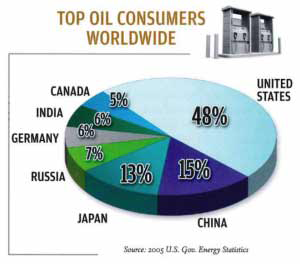Publication: One-to-One, Autumn 2006
The “GREEN MOVEMENT” came into prominence in Europe, New Zealand and Australia in the 1970’s and became known for its support of environmental and anti-war causes. By the mid-80’s, the Green Party had established itself as a political force in Western Europe and the United States, and largely shaped the positioning of “environmentally friendly” politics and business.
Today, there are “green-affiliated groups” worldwide. To their constituents, “multi-national” and “globalization” are code words for evil. The message they have managed to convey to the market is: forget your company’s bottom line, save “Mother Earth.” Given the choice, business entrepreneurs and executives decided to keep putting food on the table and ensure job opportunities for others. Meanwhile eco-terrorists who busy themselves burning SUV’s and throwing molotov cocktails during WTO protests foster an increasingly radical and dangerous image for themselves, making for an easy dismissal of green initiatives by many mainstream business and political leaders.
Setting politics aside for a moment, consider what Yale Online reports regarding a study conducted by Golden State University lasting two years, wherein the environmental records for 243 Fortune 500 companies were examined. The researchers found that firms with the highest returns on their assets had built reputations of going above and beyond their competitors in pollution control or waste reduction. Similarly, another recent study at Vanderbilt University found that eight out of ten environmentally sound companies outperform their higher-polluting counterparts. One reason: “If you’re less wasteful, you’re probably running a lean operation.”
Efficiency is the major intersection for the business and Green-minded. Case in point: the Feb-March, 2001 story from National Wildlife, of carpet manufacturer Interface, “that was excreting hundreds of gallons of wastewater and about 900 tons of pollutants each year. Then in the mid- 1990s, the company began experimenting with new ideas-from spinning polyester out of discarded soda bottles to running looms with solar power to cut waste and decrease harmful emissions by more than half. In six years, such innovations saved the firm about $114 million.”
With an eye on competition, some CEO’s are beginning to ask, “Can going ‘green’ help my company earn more green dollars, or at least keep me out of the red? Will it buy my company more good will in the community?” Call it a “lighter shade of green,” but when corporations take this approach, isn’t it a win-win for all?
The lines are blurring somewhat between the globalists and the greens.
Although some of the ideas are very controversial, economists such as Thomas Friedman are serving up some food for thought and giving us new terms such as “neogreen” (the overlap of neoconservatives and greens). Friedman, a recently self-proclaimed neogreen, has been a huge proponent of breaking America’s “oil addiction,” as President George W. Bush has frequently referred to it. Understandably, Friedman receives a cold reception to his proposal for a one dollar per gallon gasoline tax on American drivers. People tune in, however, when Friedman points out how oil impacts our foreign policy. (And no, this is not where we go off on the Iraq “war for oil” debate.)
Friedman is asking, why should the U.S. hope for change in places such as Sudan and Iran, when U.S. oil consumption leads to higher oil prices, which in turn keep these countries economically fat enough to keep social reform off the agenda? Furthermore, Friedman questions if our foreign oil addiction does not, in effect, cause the U.S. to fund both sides of the war on terror.
 It’s a question that begs to be asked: what if Mid-East oil profits began to dry up? Considering its existing high unemployment rates and repressively restricted freedom, could that be the nudge for the people of Iran to do the world a favor and establish new leadership? True, the U.S. does not buy oil directly from Iran, but as mentioned earlier, U.S. oil consumption is the major factor in today’s high oil prices, and Iran does reap the benefit. You might think that the ever – industrious Chinese and Indians could fill a U.S. oil gap, but take a look at how much oil they actually consume compared with the U.S. (see Oil Consumption Graph).
It’s a question that begs to be asked: what if Mid-East oil profits began to dry up? Considering its existing high unemployment rates and repressively restricted freedom, could that be the nudge for the people of Iran to do the world a favor and establish new leadership? True, the U.S. does not buy oil directly from Iran, but as mentioned earlier, U.S. oil consumption is the major factor in today’s high oil prices, and Iran does reap the benefit. You might think that the ever – industrious Chinese and Indians could fill a U.S. oil gap, but take a look at how much oil they actually consume compared with the U.S. (see Oil Consumption Graph).
If energy reform were seriously applied in the U.S., the effects would be exponential. Imagine the dawning of more frank dialogue with Saudi Arabia? Hezbollah, al-Qaeda and Hamas members being forced to get real jobs? A clear day in L.A.? Is all of this discussion just pie-in-the-sky? No, we can’t believe this will make the “neocons” and “eco-warriors” hold hands at the next Harmonic Convergence, but it is enough to make Venezuela’s Hugo Chavez choke on his empanada , and send Iran’s Ahmadinejad crying to his Nazi shrine room. Top that Kyoto!
Now that we’ve all been trained to shun carbs, there just may be a way we can embrace them again. Unfortunately, this is not the part where you can make a run to Krispy Kreme for intermission. Brazil has found a way to turn carbohydrates into a cost-effective alternative to gasoline and is now counting its carbs all the way to the bank. These carbs are, of course, in the form of ethanol. The Brazilian version is made from sugar cane, not corn. Ethanol is not a new idea, Henry Ford’s first car was made to run on ethanol and it seems the U.S. has been tinkering with it ever since.
Brazilians drive “flexible fuel” cars that run on either ethanol or gasoline and allow the consumer to fill up with whichever option is cheaper. Current prices in Sao Paulo have gasoline at $3.74/gal and ethanol at $2.00/gal-and ethanol is available at 29,000 gas stations from Rio to the Amazon. It was a painful 30-year process, but now Brazil has replaced about 40 percent of the country’s gasoline consumption, according to Caio Carvalhal, an analyst with Cambridge Energy Research Associates in Rio de Janeiro.
Br azil ended most government support for its sugar industry in the late 1990s, forcing sugar producers to become more efficient and helping lower the cost of ethanol’s raw material. According to the World Bank, Brazil can make ethanol for about $1 a gallon. Brazil says its ethanol exports will likely double to $1.3 billion in 2010 from $600 million in 2005, largely to Japan and Sweden. These countries hope using ethanol (which releases less carbon dioxide than fossil fuels) will help them meet their obligations under the Kyoto Protocol to cut emissions.
azil ended most government support for its sugar industry in the late 1990s, forcing sugar producers to become more efficient and helping lower the cost of ethanol’s raw material. According to the World Bank, Brazil can make ethanol for about $1 a gallon. Brazil says its ethanol exports will likely double to $1.3 billion in 2010 from $600 million in 2005, largely to Japan and Sweden. These countries hope using ethanol (which releases less carbon dioxide than fossil fuels) will help them meet their obligations under the Kyoto Protocol to cut emissions.
As amazing all of that is, researchers are now able to make straw and other plant wastes into cellulosic ethanol. Although chemically identical to ethanol produced from corn or soybeans, cellulose ethanol produces energy content three times higher than corn ethanol and emits lower levels of green-house gases. Whatever the source, burning ethanol instead of gasoline reduces carbon emissions by more than 80% while eliminating the release of acid-rain-causing sulfur dioxide. It’s enough to make the evangelicals concerned over global warming dance in the street (albeit in a decidedly non-carnival type way, of course).
Just when the U.S. begins feeling depressed about its’ procrastination in energy reform that brought gas to the point of $3.00/gal this past summer, it need only look at other prices around the world–particularly Europe. Europe (which blames U.S. oil consumption for their own high gas prices) slaps on gas taxes of 75% of the price at the pump, while Canadians pay about 40% and the U.S. about 12.5%.
God has given us the means through science and technology to improve our economy, our current situation with the Middle East and, yes, even our environment. The question is, are we willing to embrace the change necessary and be productive stewards over that process?
JONATHAN SIMPSON is a frequent contributing writer to CSM’s Marketplace Exchange.